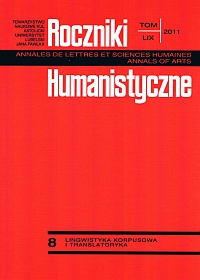Blanc : un symbole, un mot, un terme
Abstrakt
The starting point is a word from common vocabulary, chosen to pay homage to papacy – the adjective blanc (white). The paper deals with its symbolism, and then shows how the symbolic components are underlying the meanings of its polysemic senses. Attention is drawn upon the compound words that are to be considered as whole terms, with a double difficulty for the translator : recognizing and referencing. Then the linguistic derivatives of the chosen adjective are studied and, finally, research prospects are suggested, particularly concerning the translation problematics with the example of two set phrases belonging to law language : blanchir une réputation and blanchir un inculpé (to clear vs to exonerate). The starting point is a word from common vocabulary, chosen to pay homage to papacy – the adjective « blanc » (white). The paper deals with its symbolism, and then shows how the symbolic components are underlying the meanings of its polysemic senses. Attention is drawn upon the compound words that are to be considered as whole terms, with a double difficulty for the translator : recognizing and referencing. Then the linguistic derivatives of the chosen adjective are studied and, finally, research prospects are suggested, particularly concerning the translation problematics with the example of two set phrases belonging to law language: blanchir une réputation and blanchir un inculpé (to clear vs to exonerate).
Biały: symbol, słowo, termin
Punktem wyjścia artykułu jest leksem z zakresu słownictwa ogólnego – przymiotnik blanc (biały), wybrany do analizy jako swego rodzaju wyraz hołdu Papiestwu. Niniejsze opracowanie rozpoczyna się od przywołania symboliki bieli, następnie zaś pokazuje, w jaki sposób elementy symboliki zawierają się w znaczeniach wyrazów polisemicznych. Ponadto zwraca także uwagę na wyrazy złożone, stanowiące podwójną trudność dla tłumacza ze względu na rozpoznawanie (problem językoznawczy) i referencję (kognitywny). Dalsza część artykułu przedstawia derywaty językowe wybranego przymiotnika, uwidaczniające sposób konotowania pojedynczego desygnatu (niepowtarzalność każdego użycia) oraz propozycje perspektyw badawczych, dotyczących szczególnie problemów z tłumaczeniem na przykładzie dwóch idiomatycznych wyrażeń polileksykalnych z dziedziny prawa: blanchir une réputation (wybielić reputację) i blanchir un inculpé (wybielić podejrzanego).
Bibliografia
Durieux Ch., 1996-97, « Pseudo-synonymie en langues de spécialité » [in:] Cahier du CIEL, Université Paris VII (pp. 89-114).
Kleiber G., 1990, La Sémantique du prototype, Paris, PUF.
Kleiber G., 1999, Problèmes de sémantique. La polysémie en question, Lille, Presses Universitaires du Septentrion.
Reboul A. et Moeschler J., 1998, La Pragmatique aujourd’hui, Paris, Seuil (coll. Points).
Dictionnaire historique de la langue française, 1993, Paris, Le Robert. (DH)
Le Grand Robert de la langue française, 2001, Paris, Le Robert. (GR)
Copyright (c) 2011 Roczniki Humanistyczne

Utwór dostępny jest na licencji Creative Commons Uznanie autorstwa – Użycie niekomercyjne – Bez utworów zależnych 4.0 Międzynarodowe.





